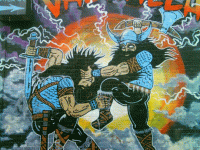Writing on the Walls: Graffiti as an Integrated Study Project
Your content has been saved!
Go to My Saved Content.Through a multidisciplinary project, students at High Tech High North County explored and addressed an issue of concern in their community of San Marcos, California -- the prevalence of tagging and graffiti. By the end, they had integrated the study of fine arts, social science, language arts and technology.
In 2007, "Brian" began his freshman year at High Tech High North County. He hated school and had run-ins with local authorities. He was without a doubt going down the wrong path, but there was something special about the boy. As his art teacher, I immediately noticed the doodles on his binder and gave him a sketchbook. Brian's graffiti-style lettering was impressive, so I encouraged him to experiment with other forms of art. He started painting on canvas and expanding his style to include images in addition to words.
Untitled graffiti art by "Brian"
Credit: Shani Leader"I had never used a canvas before," Brian explained. "My canvas had been the empty walls in the streets. Using a canvas and acrylic paint gave me another way to get out of this world and be set free into my own world. I never knew I was an artist until I had my first art teacher in high school. She has helped me turn my life around."
Along with Jennifer Pieratt, my humanities teaching partner, I saw a chance to connect with Brian through graffiti art. And that became our inspiration for Writing on the Walls.
Writing on the Walls was a semester-long service learning project in which students researched the history and lasting influence of gangs in California and conducted an ethnographic study of tagging and graffiti in the city. Students maintained video blogs as a form of ongoing reflection, and created photo essays of their experience, which they shared with younger students at a local Boys & Girls Club.
Art or Deviant Behavior?
The wonderful reality about working at a project-based learning (PBL) school is that teachers learn alongside students. The essential questions our learners pondered were questions that we also felt compelled to answer:
- What is the difference between tagging and graffiti-style art?
- How can we change society's negative perception of graffiti?
These authentic questions motivated our exploration of the graffiti story.
To help students form their own opinions, we offered them as many perspectives on the subject as we could. A representative from Public Works and the Sheriff's Department came to our school and described the process of eradicating graffiti and the consequences of graffiti for the city and for the individual. We assisted in a local graffiti abatement project. Beyond serving the community, students gained an understanding of how much time, effort and money is allocated to the removal of graffiti.
More untitled graffiti art by "Brian"
Credit: Shani LeaderTo gain another perspective, we visited nearby galleries, like the Raw Art Gallery in the neighboring city of Encinitas, where street artists like Ronald Allen Wickersham described their unconventional journey to becoming professional artists. Other artists talked about how they are not paid for their work, but nonetheless define themselves as artists. Writerz Blok is a unique space in downtown San Diego where street artists can go to express themselves, build skills, and share techniques with each other. Their motto: "Call a kid a tagger and he's a criminal. Help him become an artist and everything changes." Writerz Blok builds awareness and respect for graffiti as an art form. Students loved this opportunity to meet artists and create some of their own "street art." After visiting Writerz Blok, we were inspired to create a space where young artists at our school could express themselves in a supervised setting. Along with some dedicated parent volunteers, we constructed a large graffiti wall on our campus for students to practice their craft.
The Lens of Creativity
As we studied the difference between tagging as vandalism and graffiti as an art form, our group felt inspired to use their work for another kind of service -- creating graffiti-style art that could be shown in a professional context. The work was displayed at the Escondido Arts Partnership Gallery. Through this experience, students learned about the responsibility of working in a real professional environment, meeting deadlines and interdependently collaborating with peer artists. Ultimately, we hoped that our artwork would open public minds to the notion that graffiti is a legitimate art form when presented in a legal setting.

What I love most about teaching art is connecting with kids through something that I passionately believe is fundamental to student learning -- creativity. The creative state is a space where the mind and spirit collide, and where powerful and concrete learning happens. I've learned that connecting with kids depends on identifying something that interests them, and then teaching through that lens. That is what we hoped to do with Writing on the Walls. I believe we succeeded.
What interdisciplinary projects resonate with your students?
